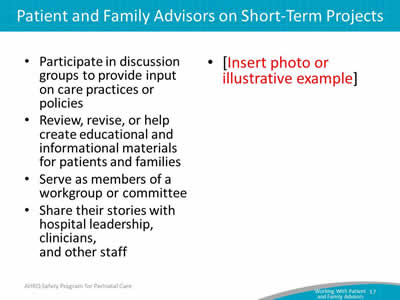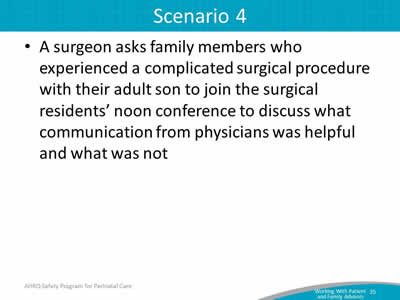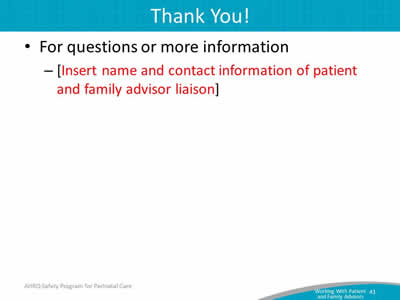Working With Patient and Family Advisors
AHRQ Safety Program for Perinatal Care
Slide 1: Working With Patient and Family Advisors

Part 1. Introduction and Overview
[Hospital Name | Presenter name and title | Date of presentation]
Strategy 1: Working With Patient and Family Advisors Training (Tool 11)
Slide 2: Today's Session

- What is patient and family engagement?
- Who are patient and family advisors? What do they do?
- What are the benefits of working with patient and family advisors?
- What are the opportunities for working with patient and family advisors?
- What are we asking you to do?
Slide 3: What Is Patient and Family Engagement?

What Is Patient and Family Engagement?
Slide 4: What Is Patient and Family Engagement?

Patient and family engagement—
- Creates an environment in which patients, families, clinicians, and hospital staff all work together as partners to improve the quality and safety of hospital care.
- Involves patients and family members as—
- Members of the health care team.
- Advisors working with clinicians and leaders to improve policies and procedures.
Slide 5: Why Patient and Family Engagement?

[Adapt to hospital]
- Include a story from leadership about the importance of patient and family engagement and goals for the effort.
- Include specific goals or data for the hospital.
- Refer to or adapt the information as needed from "How Patient and Family Engagement Benefits Your Hospital," which is included in the AHRQ Guide to Patient and Family Engagement under "Information to Help You Get Started".
Slide 6: Patient-and Family-Centered Care

- Patient and family engagement is an important part of providing patient- and family-centered care.
- Core concepts of patient- and family-centered care:
- Dignity and respect.
- Information sharing.
- Involvement.
- Collaboration.
Slide 7: Patient and Family Advisors

Who are they?
What do they do?
Slide 8: Advisors: Who They Are

- Advisors are collaborative partners in developing and revising hospital policies, procedures, and practices.
- Patients and family members who received care at this hospital and want to help improve care experiences for others:
- Rigorous application and screening process.
- Training provided.
Slide 9: Advisors: What They Do

Help us improve the quality and safety of the care we provide:
- Give input and feedback.
- Identify potential changes and improvements.
- Plan and implement changes that matter to patients and families.
Slide 10: Benefits of Working With Patient and Family Advisors

Benefits of Working With Patient and Family Advisors
Slide 11: Benefits of Working With Advisors

Patient and family advisors—
- Offer insights about what we do well and areas where changes may be needed.
- Help us develop priorities and make improvements based on patient-and family-identified needs.
- Help us come up with new ideas and solutions.
Slide 12: Benefits of Working with Advisors

Long-term benefits:
- Improved quality and safety.
- Better health outcomes for patients.
- Better business outcomes for the hospital.
- Better experiences of care for patients, family members, clinicians, and staff.
Slide 13: Why Are We Doing This?

- Consistency with our mission and vision.
- Consistency with our strategic priorities.
- Desire to demonstrate commitment to patient-and family-centered care.
- Desire to be at the forefront of where health care is going.
- [Insert hospital goal / data related to working with patient and family advisors].
Slide 14: Video

- American Hospital Association/Institute for Patient- and Family-Centered Care Video:
- Patient- and Family-Centered Care: Partnerships for Quality and Safety www.aha.org/advocacy-issues/quality/strategies-patientcentered.shtml
Slide 15: Opportunities for Working With Patient and Family Advisors

Opportunities for Working With Patient and Family Advisors
Slide 16: Working With Advisors

Presenter note: Delete slide after review
- This presentation discusses several ways of working with advisors:
- Patients and families as advisors on short-term projects, typically on an as-needed basis.
- Patients and families as advisory council members.
- Patient and family advisors as members of hospital quality and safety committees.
- Not all hospitals will choose to work with advisors in all three ways. Adapt the slides that are appropriate to the opportunities available within your organization and delete the others.
Slide 17: Patient and Family Advisors on Short-Term Projects

- Participate in discussion groups to provide input on care practices or policies.
- Review, revise, or help create educational and informational materials for patients and families.
- Serve as members of a workgroup or committee.
- Share their stories with hospital leadership, clinicians, and other staff.
- [Insert photo or illustrative example].
Slide 18: Patient and Family Advisory Councils

Presenter note: Delete slide after review
- The following slides are about patient and family advisory councils. If your hospital does not offer this opportunity, delete these slides.
Slide 19: Patient and Family Advisory Councils

- Advisory council members work together to help hospital leadership and staff integrate and apply patient and family insights:
- Identify and implement ways of improving the care experience for all patients and families.
- Discuss and plan changes to improve hospital quality and safety.
- Identify ways of improving the care experience for all patients and families.
- Formal group that meets regularly:
- Membership: Majority patients and families, small number of hospital staff and clinicians.
Slide 20: Patient and Family Advisors on Committees

Presenter note: Delete slide after review
- The following slides are about patient and family advisors as members of hospital quality and safety committees. If your hospital will not offer this opportunity, delete these slides.
Slide 21: Quality and Safety Advisor Opportunities

- Experienced advisors who have membership on quality and safety committees.
- [Insert information about specific opportunities at your hospital (either in existence or planned)]
- Names of committees.
Slide 22: Patient and Family Stories

"Facts bring us to knowledge, but stories bring us to wisdom."
Rachel Naomi Remen, M.D.
Kitchen Table Wisdom
Slide 23: Working With Patient and Family Advisors

What We Are Asking You To Do
Slide 24: What We Are Asking You To Do

Help identify prospective patient and family advisors:
- Think about patients or family members who—
- Share insights and experiences in productive ways.
- Listen well and speak comfortably.
- Express an interest in improving health care for others.
- Distribute recruitment materials:
- Brochure.
- Personal invitation and postcard.
Slide 25: Identify Potential Advisors

Look for opportunities to involve patient and family advisors:
- Invite two or three patient and family members to a team meeting to discuss their hospital experiences and provide input on policies, procedures, and practices.
- Ask patients and families to give feedback on educational or informational materials.
- Invite patients and families to present at staff orientations and in-service programs.
Slide 26: For More Information

For questions or more information—
- [Insert name and contact information of staff liaison]
- Attend Part 2 of this presentation: Building effective partnerships.
Slide 27: Working With Patient and Family Advisors

Part 2. Building Effective Partnerships
[Hospital Name | Presenter name and title | Date of presentation]
Strategy 1: Working With Patient and Family Advisors Training (Tool 11)
Slide 28: Today's Session

- What does it mean to work with patient and family advisors in true partnerships?
- What are some principles for effective partnerships?
- What are the opportunities for working with patient and family advisors?
Slide 29: Working With Patient and Family Advisors

Patients and family members as—
- Essential members of the health care team.
- Collaborative partners in hospital policies, procedures, and practices.
Slide 30: Principles for Effective Partnerships

Principles for Effective Partnerships
Slide 31: Principles for Effective Partnerships (Part 1)

- Practice exercise: Patient and family engagement or not?
Slide 32: Scenario 1

- Three patient and family advisors are invited to join a patient safety team that is beginning an initiative to improve medication reconciliation.
Slide 33: Scenario 2

- An administrator invites patients and families to comment on the final plans for the facility's upcoming renovation.
Slide 34: Scenario 3

- A multidisciplinary committee develops new educational materials about diabetes management and treatment for patients and their families.
Slide 35: Scenario 4

- A surgeon asks family members who experienced a complicated surgical procedure with their adult son to join the surgical residents' noon conference to discuss what communication from physicians was helpful and what was not.
Slide 36: Principles for Effective Partnership (Part 2)

- Define a clear role for advisor participation:
- Provide opportunities to contribute where advisors can make a tangible difference.
- Give information about the purpose, goals, and intended outcomes of the effort.
- Clearly define expectations, including timelines, deadlines, and responsibilities.
Slide 37: Principles for Effective Partnership

- Designate a staff member or key contact for working with patient and family advisors.
- Provide background information on the project:
- Avoid acronyms and jargon whenever possible.
- Invite participation.
- Listen with an open mind.
Slide 38: Principles for Effective Partnership

- Practice exercise: Readiness to collaborate with patients and family members.
Slide 39: Identifying Opportunities

Practice exercise: Identify areas in which patient and family advisors could make a contribution.
- Quality improvement and safety initiatives.
- Facility design.
- Patient and family participation in care and decision making.
- Patient and family information and education.
- Health information technology.
- Clinician and staff training.
Slide 40: Taking Action

- Identify opportunities for working with patient and family advisors:
- Short-term projects.
- Committee membership.
- Fill out the patient and family advisor request form or contact the staff liaison.
Slide 41: Thank You!

- For questions or more information:
- [Insert name and contact information of patient and family advisor liaison]
Slide 42: Disclaimer

Every effort was made to ensure the accuracy and completeness of this resource. However, the U.S. Department of Health and Human Services makes no warranties regarding errors or omissions and assumes no responsibility or liability for loss or damage resulting from the use of information contained within.
The U.S. Department of Health and Human Services cannot endorse, or appear to endorse derivate or excerpted materials, and it cannot be held liable for the content or use of adapted resources. Any adaptations of this resource must include a disclaimer to this effect.
Reference to any specific commercial products, process, service, manufacturer, company, or trademark does not constitute endorsement or recommendation by the U.S. Government, the U.S. Department of Health and Human Services, or AHRQ of the linked Web resources or the information, products, or services contained therein. The Agency does not exercise any control over the content on these sites.



